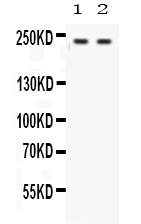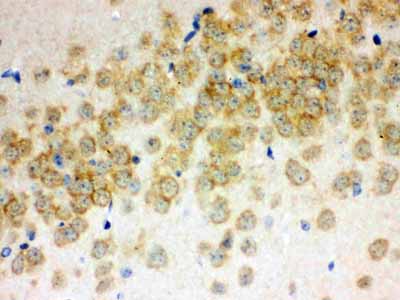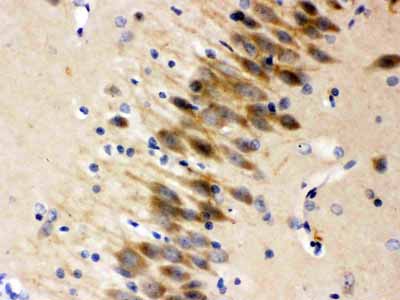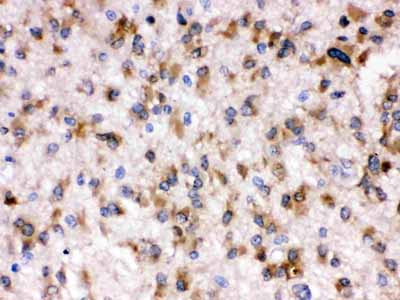Anti-Otoferlin Picoband Antibody
- SPECIFICATION
- CITATIONS: 1
- PROTOCOLS
- BACKGROUND

Application
| WB, IHC-P |
|---|---|
| Primary Accession | Q9HC10 |
| Host | Rabbit |
| Reactivity | Human, Mouse, Rat |
| Clonality | Polyclonal |
| Format | Lyophilized |
| Description | Rabbit IgG polyclonal antibody for Otoferlin(OTOF) detection. Tested with WB, IHC-P in Human;Mouse;Rat. |
| Reconstitution | Add 0.2ml of distilled water will yield a concentration of 500ug/ml. |
| Gene ID | 9381 |
|---|---|
| Other Names | Otoferlin, Fer-1-like protein 2, OTOF, FER1L2 |
| Calculated MW | 226753 MW KDa |
| Application Details | Immunohistochemistry(Paraffin-embedded Section), 0.5-1 µg/ml, Human, Mouse, Rat, By Heat Western blot, 0.1-0.5 µg/ml, Human, Rat |
| Subcellular Localization | Cytoplasmic vesicle, secretory vesicle, synaptic vesicle membrane ; Single-pass type II membrane protein . Basolateral cell membrane ; Single-pass type II membrane protein . Endoplasmic reticulum membrane ; Single-pass type II membrane protein . Cell membrane ; Single-pass type II membrane protein . Detected at basolateral cell membrane with synaptic vesicles surrounding the ribbon and at the presynaptic plasma membrane in the inner hair cells (IHCs). Colocalizes with GPR25 and RAB8B in inner hair cells (By similarity). . |
| Tissue Specificity | Isoform 1 and isoform 3 are found in adult brain. Isoform 2 is expressed in the fetus and in adult brain, heart, placenta, skeletal muscle and kidney. |
| Protein Name | Otoferlin |
| Contents | Each vial contains 5mg BSA, 0.9mg NaCl, 0.2mg Na2HPO4, 0.05mg NaN3. |
| Immunogen | A synthetic peptide corresponding to a sequence at the C-terminus of human Otoferlin (1831-1863aa QIWDADHFSADDFLGAIELDLNRFPRGAKTAKQ), identical to the related mouse and rat sequences. |
| Purification | Immunogen affinity purified. |
| Cross Reactivity | No cross reactivity with other proteins |
| Storage | At -20˚C for one year. After r˚Constitution, at 4˚C for one month. It˚Can also be aliquotted and stored frozen at -20˚C for a longer time.Avoid repeated freezing and thawing. |
| Sequence Similarities | Belongs to the ferlin family. |
| Name | OTOF |
|---|---|
| Synonyms | FER1L2 |
| Function | Key calcium ion sensor involved in the Ca(2+)-triggered synaptic vesicle-plasma membrane fusion and in the control of neurotransmitter release at these output synapses. Interacts in a calcium-dependent manner to the presynaptic SNARE proteins at ribbon synapses of cochlear inner hair cells (IHCs) to trigger exocytosis of neurotransmitter. Also essential to synaptic exocytosis in immature outer hair cells (OHCs). May also play a role within the recycling of endosomes (By similarity). |
| Cellular Location | Cytoplasmic vesicle, secretory vesicle, synaptic vesicle membrane {ECO:0000250|UniProtKB:Q9ESF1}; Single-pass type II membrane protein {ECO:0000250|UniProtKB:Q9ESF1}. Basolateral cell membrane {ECO:0000250|UniProtKB:Q9ESF1}; Single-pass type II membrane protein {ECO:0000250|UniProtKB:Q9ESF1}. Endoplasmic reticulum membrane {ECO:0000250|UniProtKB:Q9ESF1}; Single-pass type II membrane protein {ECO:0000250|UniProtKB:Q9ESF1}. Golgi apparatus membrane {ECO:0000250|UniProtKB:Q9ESF1}; Single-pass type II membrane protein {ECO:0000250|UniProtKB:Q9ESF1}. Presynaptic cell membrane {ECO:0000250|UniProtKB:Q9ESF1}; Single-pass type II membrane protein {ECO:0000250|UniProtKB:Q9ESF1}. Cell membrane {ECO:0000250|UniProtKB:Q9ESF1}; Single-pass type II membrane protein {ECO:0000250|UniProtKB:Q9ESF1}. Note=Detected at basolateral cell membrane with synaptic vesicles surrounding the ribbon and at the presynaptic plasma membrane in the inner hair cells (IHCs) at postnatal day 30 (P30). Colocalizes with GPR25 and RAB8B in inner hair cells {ECO:0000250|UniProtKB:Q9ESF1} |
| Tissue Location | Isoform 1 and isoform 3 are found in adult brain. Isoform 2 is expressed in the fetus and in adult brain, heart, placenta, skeletal muscle and kidney |

Provided below are standard protocols that you may find useful for product applications.
Background
Otoferlin is a protein that in humans is encoded by the OTOF gene. Mutations in this gene are a cause of neurosensory nonsyndromic recessive deafness, DFNB9. The short form of the encoded protein has three C2 domains, a single carboxy-terminal transmembrane domain found also in the C. elegans spermatogenesis factor FER-1 and human dysferlin, while the long form has six C2 domains. The homology suggests that this protein may be involved in vesicle membrane fusion. Several transcript variants encoding multipleisoforms have been found for this gene.
If you have used an Abcepta product and would like to share how it has performed, please click on the "Submit Review" button and provide the requested information. Our staff will examine and post your review and contact you if needed.
If you have any additional inquiries please email technical services at tech@abcepta.com.














 Foundational characteristics of cancer include proliferation, angiogenesis, migration, evasion of apoptosis, and cellular immortality. Find key markers for these cellular processes and antibodies to detect them.
Foundational characteristics of cancer include proliferation, angiogenesis, migration, evasion of apoptosis, and cellular immortality. Find key markers for these cellular processes and antibodies to detect them. The SUMOplot™ Analysis Program predicts and scores sumoylation sites in your protein. SUMOylation is a post-translational modification involved in various cellular processes, such as nuclear-cytosolic transport, transcriptional regulation, apoptosis, protein stability, response to stress, and progression through the cell cycle.
The SUMOplot™ Analysis Program predicts and scores sumoylation sites in your protein. SUMOylation is a post-translational modification involved in various cellular processes, such as nuclear-cytosolic transport, transcriptional regulation, apoptosis, protein stability, response to stress, and progression through the cell cycle. The Autophagy Receptor Motif Plotter predicts and scores autophagy receptor binding sites in your protein. Identifying proteins connected to this pathway is critical to understanding the role of autophagy in physiological as well as pathological processes such as development, differentiation, neurodegenerative diseases, stress, infection, and cancer.
The Autophagy Receptor Motif Plotter predicts and scores autophagy receptor binding sites in your protein. Identifying proteins connected to this pathway is critical to understanding the role of autophagy in physiological as well as pathological processes such as development, differentiation, neurodegenerative diseases, stress, infection, and cancer.




